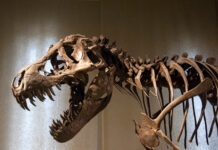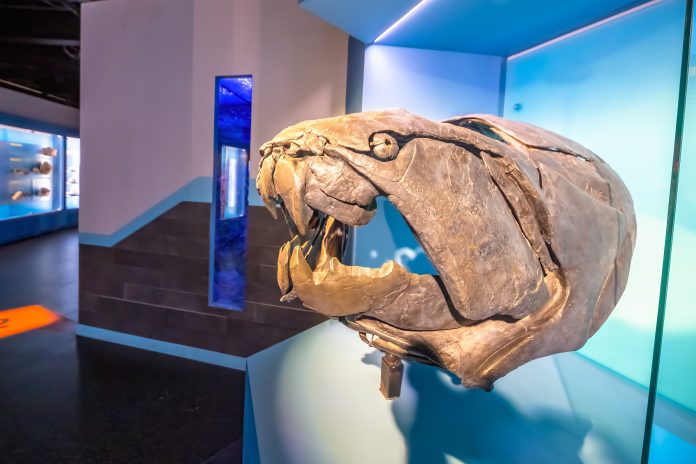
Placoderms are some of the best-known fossil fish of the ancient seas because of their hard dermal plates. “Placo” means plate and “derm” means skin.
As a young boy growing up in fossil-rich western New York, I would spend untold hours with my fossil hunting tools walking the rocky outcrops of the Niagara Escarpment, the shore of an ancient Silurian Sea, collecting hundreds of marine fossils including brachiopods and crinoids. The joy of discovery spurred me to learn more. Who knew my road would lead me to Michigan? Some 40 years later in northern Michigan, I happened upon a fossil I had never seen. Little did I know of the wonder and amazement of finding armor-plated fish with a hammer and chisel.
Armored Fish Types
These fish had hard plates on their head section and the part of the thorax just behind the head. They also sported large flat bony plates. Since soft tissue generally does not fossilize, these plates are usually the only evidence we are able to find. They were a group of now-extinct prehistoric jawed fish that were abundant in ancient seas.
The placoderms occupied two major subgroups: Arthrodires and Antiarchs.
Arthrodire placoderms are the most well-known and abundant placoderm fossils found. They are known for a movable joint between the head and body. In fact, Arthrodire is Greek for “jointed neck.”
Antiarchs are less common and more flattened. The Antiarchs also generally had armor-plated pectoral fins and a “box-shaped” head.
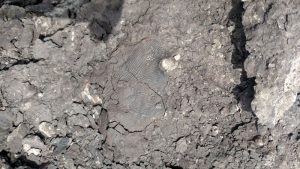 Diverse Placoderms
Diverse Placoderms
Placoderms, among other types of fish, reached their greatest diversity during the Devonian so much so that the Devonian is called “The Age of Fish.” They were a group of fish that had jaws but no teeth. Instead, they had “tooth-like” structures that extended down to the mouth, a continuation of the bony plates of the head. There was also a great diversity in size and shape between the species.
Where the plates met, some were slightly articulated and able to move. This allowed the fish to swim more easily rather than being stiff and unmoving. Often the plates are found disarticulated but in some areas of the world, they can be found as complete minus the soft tissues.
Dunkleosteus
One of the largest species of placoderm was the famous dunkleosteus which could grow to a length of 33 feet. One of the smallest of the armored fish was bothriolepis which was only four inches at the widest part of the skullcap.
Dunkleosteus was believed to be the largest predator at the time. Fossils of this creature have normally been found in the shales near Cleveland, Ohio. Cast models of a complete skull can be found in many museums around the world.
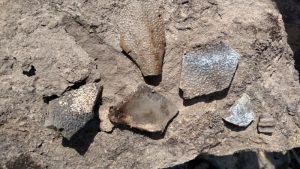 Placoderms Found Worldwide
Placoderms Found Worldwide
Placoderms numbered around 400 different species and occupied fresh and saltwater environments. However, most of the placoderm material has been found in marine sediments. As one of the first jawed fish, they were almost certainly predators of the ancient waters.
They have been studied because of the development of primitive jaws. This is the first time in fossil records that we see jaws in a vertebrate creature.
Placoderns and Live Birth?
Using modern scientific techniques and equipment, such as CT and MRI scans, several leading placoderm specialists have discovered that some placoderms may have given birth to live young.
Several species have been found and extensively studied where soft tissue has been preserved. One such specimen was studied by John A. Long of Australia and has yielded some fascinating results.
“The new specimen, remarkably preserved in three dimensions, contains a single, intra-uterine embryo connected by a permineralized umbilical cord. An amorphous crystalline mass near the umbilical cord possibly represents the recrystallized yolk sac.” -Long, J., Trinajstic, K., Young, G. et al. Live birth in the Devonian period. Nature 453, 650-652 (2008).
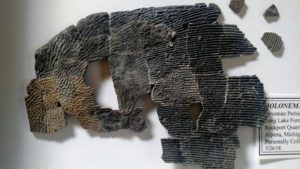 Collecting in Michigan
Collecting in Michigan
Placoderm armor plates were adorned with texture. Some had small bumps or tubercules on the armor as in the protitanichtys. Others had nearly parallel lines as in the Holonema also found in Michigan.
In the case of the placoderms that I collect in Michigan; I wander in search of the distinct texture of the fish plate. Often in the quarries, I search for the plates that have weathered out of the shale. Often the plates themselves are broken into dozens of pieces. At this point, it is necessary to scour the site looking for every piece I can find. The challenge is to return home and put the puzzle pieces back together.
This story about placoderms previously appeared in Rock & Gem magazine. Click here to subscribe. Story and photos by Joseph J. “PaleoJoe” Kchodl.



